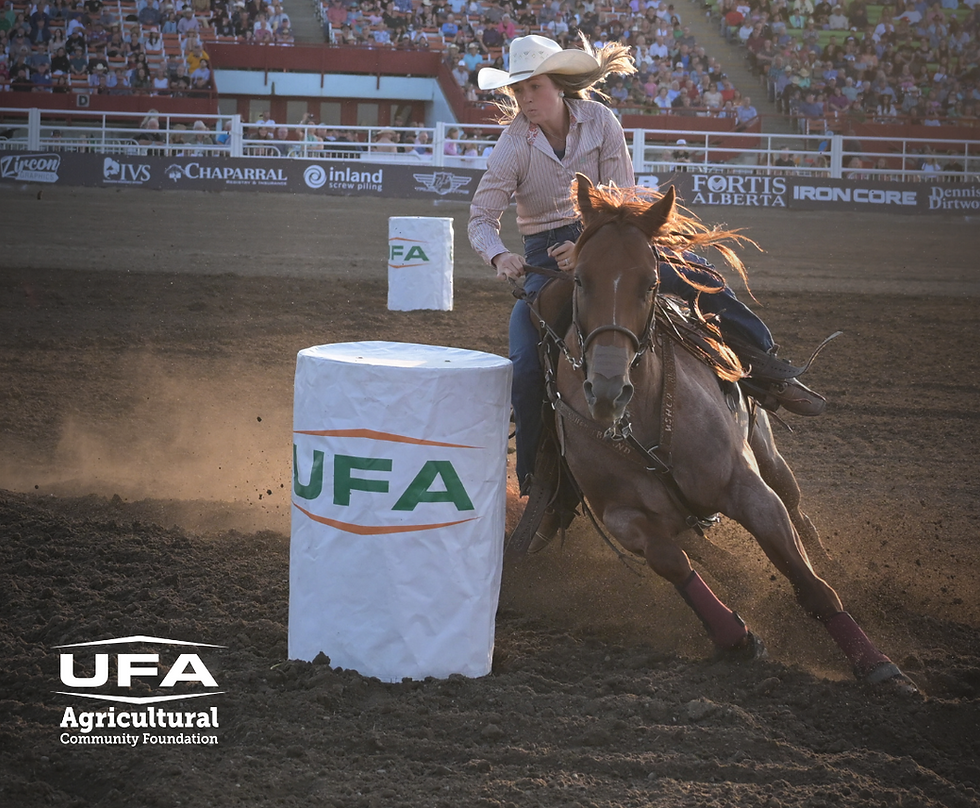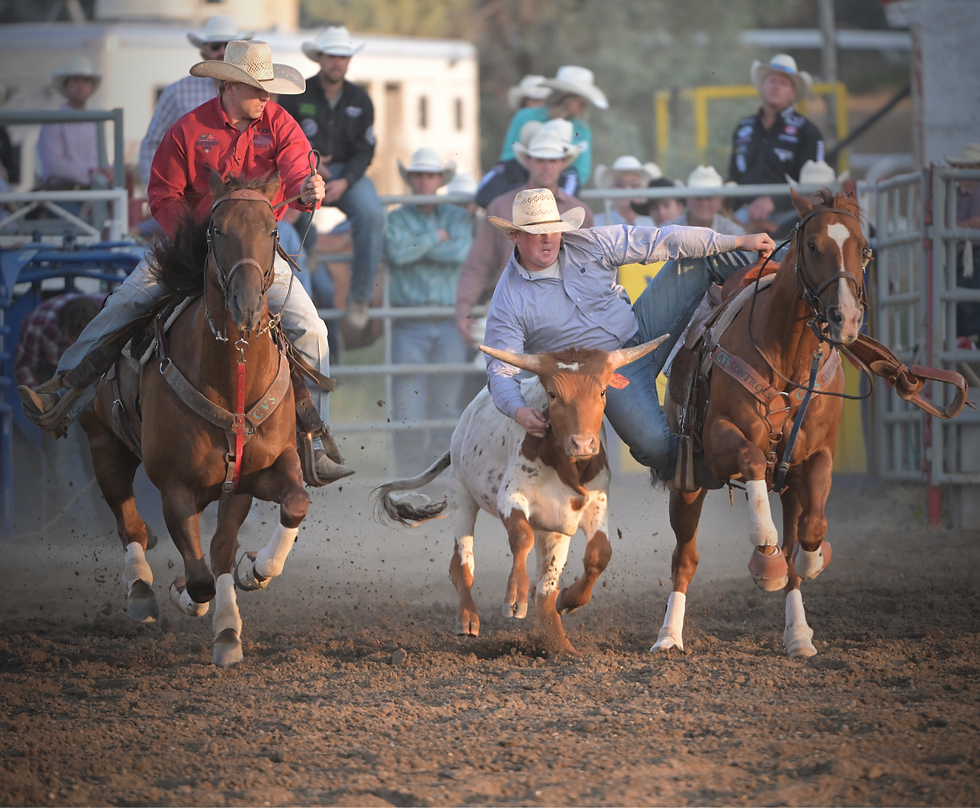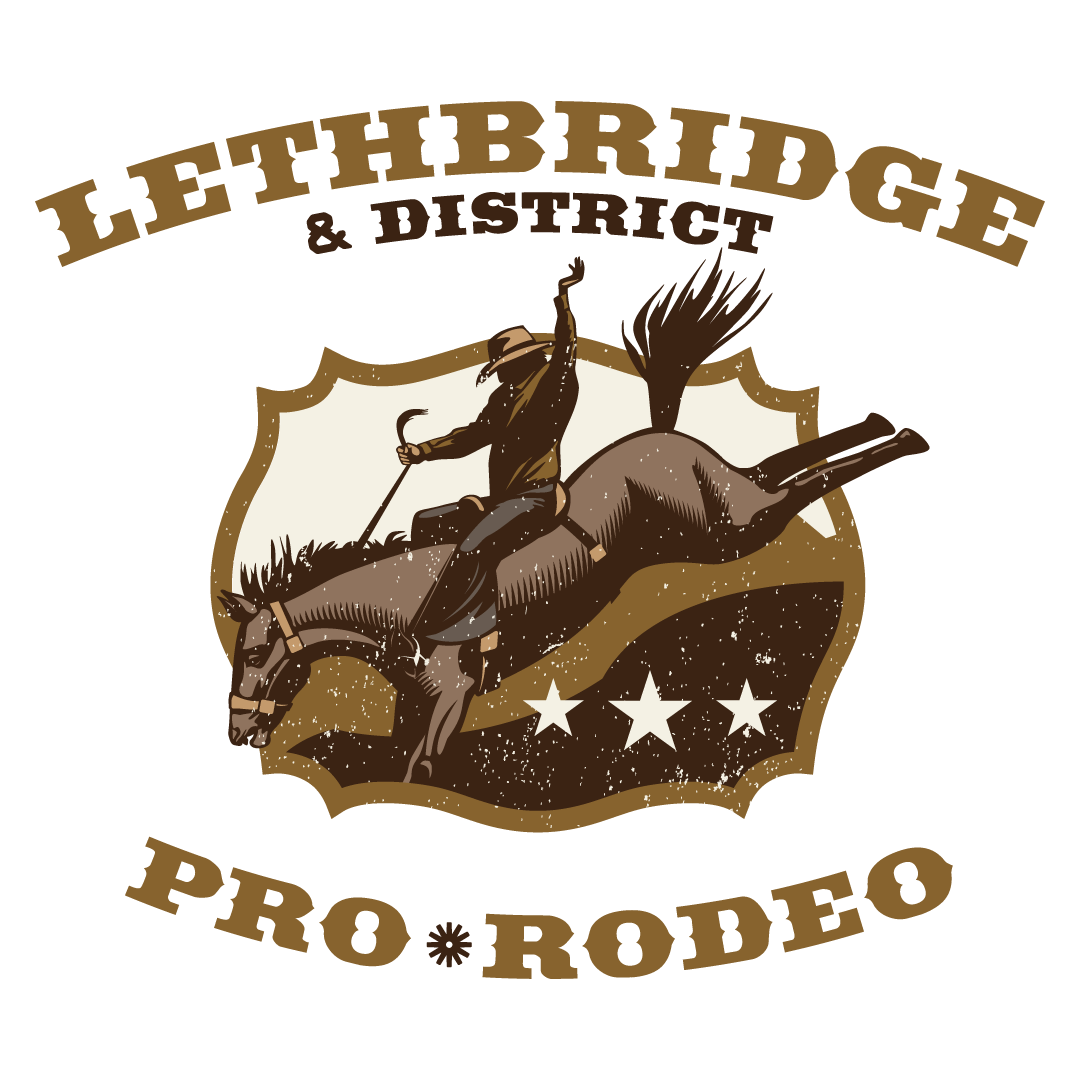One of Canada’s Largest
Professionally Sanctioned Rodeos

Over 125
years old

On the SMS Equipment Pro Rodeo Tour

See top Canadian and American rodeo athletes


Ladies Barrel Racing presented by UFA Agricultural Community Foundation
This event requires control, attention to detail, and a close partnership between horse and rider. Competing against the clock, contestants circle three barrels in a cloverleaf pattern and race back across the scoreline. Time is measured with an electronic eye timer, and a hundredth of a second can determine who wins. A rider may touch a barrel, but if she knocks one over a five-second penalty is added to her total time.
.png)
Bareback
In the Bareback event, the rider holds on to the leather handhold of a rigging—a pad wrapped around the bucking horse’s girth—as he first extends his feet far forward. He then pulls his feet back up toward the rigging in a spurring motion. The higher the spurs, the higher the score.
The stress on the cowboy’s arm is intense as it absorbs most of the horse’s power, but he needs to hold on for at least 8 seconds.
.png)
Steer Wrestling
This event requires coordination and strength. The steer wrestler waits on horseback behind a rope barrier. When he gives a nod, the steer is released and gets a 12-ft. head start. The cowboy chases the steer, then drops from his horse and grabs its horns to bring it to a halt. The steer must be on its feet before being rolled to the ground. Once on its side with all legs extended, the official time is taken. An extra horse, ridden by a hazer, is required to keep the steer running straight.

Tie Down Roping
Tie down roping is the most technical event in rodeo. At the start of the run, the roper must remain behind the barrier until the calf crosses the scoreline. Breaking the barrier adds ten seconds to the roper’s time. After roping the calf, the cowboy dismounts from his horse, runs down his rope, and lays the calf down by hand. If the calf is down when he reaches it, he must allow the calf to get up and then lay it down. The roper then ties any three legs with a “piggin’ string” (a shorter rope he carries between his teeth). The tie must hold for six seconds after the roper remounts his horse. The work of the horse is crucial; he must rate the speed of the calf, stop on cue in a single stride, then hold the rope taut while the roper runs to his calf.

Saddle Bronc
In the “classic event of rodeo”, the rider spurs from the animal’s shoulders in an arc-like motion toward the back of the saddle in time with the bronc’s actions. The cowboy rides in an “Association Saddle” with no horn while holding onto a braided buck rein. He wears spurs with dull rowels and chaps of light leather. The cowboy places his hand on the rein carefully to maintain balance and avoid either being pulled down over the front end or launched out ‘the back door’. To qualify for a score, the rider must have his boots over the break of the horse’s shoulders until the horse has completed his first jump out of the chute. He cannot touch any part of the animal or equipment with his free hand, lose a stirrup, or get bucked off before the end of the eight-second ride. The higher and harder the horse bucks and the better the cowboy spurs the higher the score.
.png)
Team Roping
Two contestants, two horses, two ropes, one steer, and one barrier rope. Team roping requires close cooperation and timing between highly skilled ropers, a header, and heeler. As in other timed events, the team ropers start from boxes on each side of the chute from which the steer is released into the arena. The steer gets a head start depending on the length of the arena. The header takes off in pursuit, with the heeler trailing slightly behind. If the header breaks the barrier before the steer completes its head start, the ropers are assessed a 10-second penalty. Once the header makes his catch he turns the steer to expose the back legs to the heeler. The heeler then attempts to rope both hind legs. If only one is caught, there is a five-second penalty. The clock is stopped when there is no slack in the ropes and the horses are facing each other.

Breakaway
Breakaway Roping is an exciting new event making an appearance on the Canadian rodeo scene. It is a variation of calf roping where a calf is roped, but not thrown and tied. Featuring a calf and one mounted rider, the calf is released from a chute while the horse and rider wait in a box next to the chute that has a spring-loaded rope, known as the barrier, stretched in front. A light rope is fastened from the chute to the calf’s neck, releasing once the calf is well away from the chute releasing the barrier, which is used to ensure that the calf gets a head start. Once the barrier has released, the horse runs out of the box while the roper attempts to throw a lasso around the neck of the calf. Once the rope is around the calf’s neck, the roper signals the horse to stop suddenly. The rope is tied to the saddle horn with a string. When the calf hits the end of the rope, the rope is pulled tight and the string breaks. The breaking of the string marks the end of the run. The fastest run wins.
.png)
Bull Riding presented by North & Company LLP
Rodeo’s most dangerous event and the toughest eight seconds in sport. The bull rider inserts his gloved hand into the handhold of a flat, braided rope which is passed around the girth of the bull, into the palm of the hand, around behind the wrist, and into the palm of the hand one more time. A weighted cowbell hangs on the underside of the rope allowing it to fall free when the ride is completed. During the eight-second ride, the cowboy must keep himself close up on the handhold to prevent his arm from straightening and jerking his hand loose at the same time keeping his free hand from touching the bull. Riders are not required to spur, as staying on these strong, athletic, loose-hided and often cantankerous animals is difficult enough. But if the cowboy is able to use his feet, he can improve the mark from the judges. Rather than pick-up men, skilled ‘’bullfighters’ distract the bull at the end of the ride to allow that cowboy to escape to safety.
.png)
Relay Races presented by Rocky Mountain Turf Club
Featured nightly, the Relay Races are one of the most high-intensity elements of the Lethbridge & District Pro Rodeo. Often referred to as “North America’s original extreme sport” the races have been a part of Indigenous life for hundreds of years. Experience horse racing like never before as riders race bareback in laps around a track and exchange horses after every lap by jumping from one horse to another.
Experience The West

NEARLY $100,000 IN CASH PRIZES
LOCAL AND NATIONAL CELEBRITY APPEARANCES
A PRIZE PACKAGE INCLUDING BOOTS, VESTS, AND MORE FROM OUR RODEO PARTNERS.

Hometown of Award-Winning Rodeo Stock Contractor Duane Kesler
Lethbridge is the hometown and closest rodeo for Duane Kesler. His stock has been featured in the largest rodeos in North America including the National Finals Rodeo and the Calgary Stampede. Kesler Rodeo has been awarded Stock Contractor of the Year in Canadian Pro Rodeo more times than any other Rodeo Contractor.

Steeped in Legacy
The Lethbridge & District Pro Rodeo is a legacy showcase of southern Alberta sport—it is ingrained in our history, people, and culture. Stories go back more than 125 years of rodeo legends earning their reputation through events in Lethbridge and southern Alberta.
The Lethbridge & District Pro Rodeo has lived through the evolution of the rodeo industry and is now proud to be a stop on the SMS Equipment Pro Rodeo Tour. Notably, we are the closest Canadian Professional Rodeo to the US border which helps us attract top American rodeo athletes.
Purchase tickets by 11:59 PM on August 26
Lethbridge & District Exhibition’s Lotteries program is once again giving back to the community, announcing the YWCA Lethbridge & District as its community partner for its 2023 50/50 Lottery campaign.
YWCA Lethbridge & District has been a staple in Southern Alberta for more than 60 years, continuing to grow and respond to the needs of the community. Housing, homelessness, poverty, domestic and sexual violence, volunteerism, youth empowerment, leadership and a place to belong are all addressed at YWCA.
Our Partners







.png)

.jpg)
.png)



.jpg)











.png)

.png)



































.png)








.png)













.png)
.jpg)














.png)


